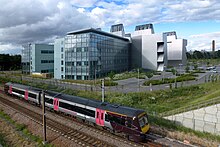 The new building of the LMB viewed from the Cambridgeshire Guided Busway bridge in June 2013 | |
| Abbreviation | MRC LMB |
|---|---|
| Location |
|
| Coordinates | 52°10′35″N 0°08′35″E / 52.1763°N 0.1430°E |
| Fields | Molecular biology |
Director | Jan Löwe |
Parent organization | Medical Research Council |
| Website | www2 |
The Medical Research Council (MRC) Laboratory of Molecular Biology (LMB) is a research institute in Cambridge, England, involved in the revolution in molecular biology which occurred in the 1950–60s. Since then it has remained a major medical research laboratory at the forefront of scientific discovery, dedicated to improving the understanding of key biological processes at atomic, molecular and cellular levels using multidisciplinary methods, with a focus on using this knowledge to address key issues in human health.[1][2][3]
A new replacement building constructed close by to the original site on the Cambridge Biomedical Campus was opened by Queen Elizabeth II in May 2013.[4] The road outside the new building is named Francis Crick Avenue after the 1962 joint Nobel Prize winner and LMB alumnus, who co-discovered the helical structure of DNA in 1953.[5]
- ^ "MRC Laboratory of Molecular Biology". www.ukri.org. Retrieved 1 March 2022.
- ^ Brackley, Paul (12 December 2018). "Dr Jan Löwe on the next scientific frontier for the MRC Laboratory of Molecular Biology". Cambridge Independent. Retrieved 1 March 2022.
- ^ Brackley, Paul (14 February 2018). "Dr Jan Löwe says he's 'humbled' to take over as director of MRC Laboratory of Molecular Biology". Cambridge Independent. Retrieved 1 March 2022.
- ^ Cite error: The named reference
Openingwas invoked but never defined (see the help page). - ^ Finch, John (2013). A Nobel Fellow On Every Floor : a History of the Medical Research Council Laboratory of Molecular Biology. New York: Icon Books. pp. 27–30. ISBN 978-1-84831-670-6. OCLC 865330798.